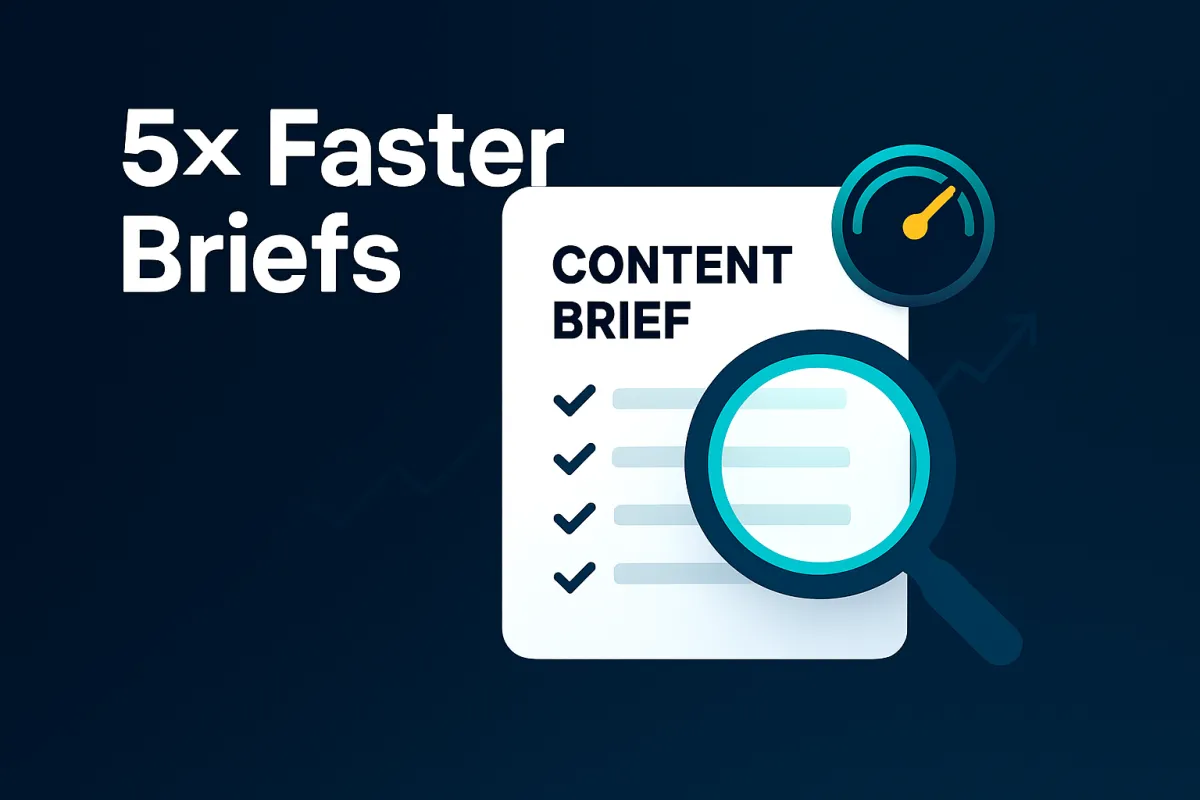Freelance SEO Writers: Map Search Intent & Create Content Briefs 5× Faster with Frase
A 15-minute Frase content brief workflow for busy freelancers

If you handle multiple client blogs, research and outlining take the most time. The fix isn't to work longer but to work smarter. This guide shows freelance SEO writers how to map search intent and build a strong, ready-to-rank Frase content brief in minutes, not hours.
Why this works:
- You map intent first, then let Frase handle most of the SERP research.
- You adjust the auto-brief so it fits what searchers really want.
What you'll learn:
- What an SEO content brief is and what to include
- How to map search intent quickly
- A clear 5-step workflow using Frase
- A short case study showing hours saved
What is an SEO content brief (and why freelancers need one)
An SEO content brief is a plan for a piece designed to rank. It outlines the keyword, search intent, structure, and notes like audience, subtopics, and length so you draft correctly the first time. Semrush says briefs hold "critical details and instructions like search intent, target keywords, competitive analysis, and desired word count." Here's a clear definition and checklist.
For freelancers, a good brief means fewer rewrites, clearer direction, and content aligned with what both users and clients expect.
Search intent mapping: the required step
Search intent is the searcher's goal: informational, navigational, commercial, or transactional. If you get it wrong, your piece won't rank. Moz explains the categories and why the format must match the intent. Read the overview.
Fast ways to check intent:
- Look at the SERP: how-tos, lists, or definitions usually mean informational. Product pages mean transactional. Comparisons often mean commercial.
- Match format to query: "How to…" usually means a step guide. "Best…" usually means a comparison. This guide helps with format mapping.
The freelancer's 5-step workflow with Frase
This takes about 15–30 minutes.
Drop your keyword into Frase
- Start a new document and add your keyword.
- Frase gathers the top results, headings, and questions in one place.
Map intent before the outline
- Skim titles and formats. If all top results are guides, yours should be too.
- Note themes that repeat across results. These are essentials for your outline.
Generate a draft outline
- In the Outline tab, Frase's tool can:
- Auto-generate headings
- Combine H2/H3s from competitors
- Or use Automated Content Brief for questions and talking points.
- Match the outline to the format in the SERP.
Customize to intent
- Adjust H2s so they solve the user's problem.
- Add a unique point competitors missed.
- Keep it clean with H2/H3s, bullet notes, and any key stats.
Finalize and hand off
- Click "Insert Brief into Editor" and export/share it.
- Make sure the brief has: keyword, variants, intent, outline, points, FAQs, word count, and links.
Want to see the full workflow? Frase Review 2025: From Keyword to Rank-Ready Draft in 15 Minutes
Mini case study
Content strategist Natalie says her tasks dropped from 3–4 hours to 30 minutes using Frase. With multiple assignments, this adds up to big time savings and more capacity for other work.
Checklist: what to include in a Frase content brief
- Target keyword and variants
- Search intent and format format guidance
- H2/H3 outline
- Bullet notes per section
- FAQs from PAA or communities
- Word count and SEO notes
- Audience/tone from client
- Sources to cite
Pro tips: AI + human judgment
- Start with intent. Skim the SERP first so your structure fits searcher goals. Intent mismatch kills rankings.
- Add your own angle or detail so it isn't just a copy of competitors.
- Treat AI output as a draft. Frase speeds up research, but you make it unique.
- You can brief in Frase and draft elsewhere if you prefer.
Frase vs. Surfer: Pick based on your main bottleneck: research or on-page SEO. See more here: Frase vs. Surfer SEO: Which Tool is Best for You?
Quick answers
What is a content brief?
- It's a document with keyword, intent, structure, and notes like subtopics and word count. See Semrush's definition.
How do I match format to intent?
- Use the query and SERP. "How to" = guide, "Best" = list, "What is" = definition. Format examples.
Why does intent matter?
- Because Google ranks content that best meets the searcher's goal. Moz's guide explains.
The bottom line
For freelance SEO writers, an intent-first process with Frase cuts hours of research to 15–30 minutes. Map intent from the SERP, generate an automated brief, then refine it yourself. You'll deliver better outlines, faster drafts, and fewer rewrites while keeping clients satisfied.





